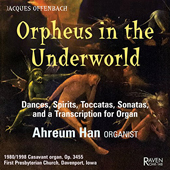
COLLECTIONS

Jean Berveiller: Mouvement
Jacques Offenbach: Overture to Orpheus in the Underworld, transcribed by Ahreum Han
Johann Sebastian Bach: Trio Sonata No. 3 in D Minor, BWV 527
Guy Bovet: Hamburger Totentanz
Louis Vierne: Naïades, Opus 55, no. 4
Charles-Marie Widor: Toccata from Symphony No. 5, Opus 41, no. 1
Johannes Matthias Michel: Organ, Timbrel, and Dance - Swing Five, Bossa Nova, Afro-Cuban
Joseph Jongen: Sonata Eroïca, Opus 94
There's a little something for everyone on this new Raven pipe organ recording featuring organist Ahreum Han playing the 1980/1998 Opus 3455 Casavant
Organ of the First Presbyterian Church in Davenport, Iowa. It's a set of varied and eclectic pieces that approach the instrument from wildly differing angles and perspectives, but in the end
individually and collectively produce the same impressive results, be it by ingenious counterpoint, clever adaptation, or full aural onslaught.
For starters, Ahreum Han's own clever transcription of Jacques Offenbach's Overture to Orphée aux enfers which includes
the famous can-can segment, is as much fun to listen to as I'm sure it is to play. Han's organ registration always serves to highlight the leading melody as well as define it's full orchestral support.
At the end both hands and feet release a volley of notes that make this massive instrument seem light-footed. At the other end of the spectrum is one of the best examples of Johann Sebastian Bach's
contrapuntal genius. As its title implies, the Trio Sonata No. 3 in D Minor is a piece in which the right hand, left hand and feet each play their own independent,
individual lines that merge together. It's like having the parts for three seperate musicians played by a single person and is very difficult to master, despite having been written as teaching material
for his eldest son. Again the voicing of the organ for this work brings out the clarity of the individual lines. The Hamburger Totentanz by Guy Bovet
injects a slight sense of humour to the program in its inclusion of subtle quotes from famous pieces within its motoric momentum. The organ "fireworks" come in the form of the famous
Toccata from Symphony No. 5 by Charles-Marie Widor, one of the top crowd pleasers in the organ repertoire. The slightly slower tempo that Ahreum Han
applies to this one allows for clarity within the flurry of notes that sometimes become a blur caused by the building's reverberant acoustics. A Hammond B3 organ may be better suited when playing
the Organ, Timbrel, and Dance - Swing Five, Bossa Nova, Afro-Cuban by the German organist/composer Johannes Matthias Michel (b. 1962)
as a jazz nightclub would be a better venue for this type of piece, but again the well-judged use of stops and couplers of this Casavant organ make it work. And last but not least, if you would like
to dispose of your neighbours, then the Sonata Eroïca by Belgian composer Joseph Jongen will do the trick. When its well-developed main
theme returns at the end and is deployed on the mighty pedals under massive chords on the keyboards, the neighbours will pack up and leave, not only because the organ at this point will force
your speakers to displace lots of air, but because they will think you've gone completely mad.
Korean organist Ahreum Han is Director of Music and Organist at First Presbyterian Church in Fort Worth, Texas, and has received numerous top prizes from various music
competitions. The Casavant organ revised in 1998 now includes 61 ranks and combination action with 128 levels of memory, is MIDI equipped and includes, amongst others, a 32' Contra Trompette
stop in the pedals. Enough to grab anyone's attention!
Below is a short video of organist Ahreum Han playing a segment from a different Trio Sonata by J. S. Bach, on the same Casavant organ used in this recording.
Jean-Yves Duperron - March 2018